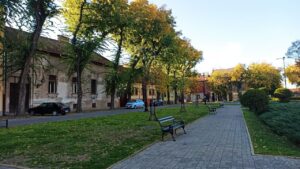Зелене површине Суботице: прошлост и садашњост.
Subotica, a charming city in northern Serbia, is known for its rich history, stunning architecture, and vibrant culture. But one of its most delightful features often goes unnoticed: the green spaces that dot the urban landscape. From parks to gardens, these green areas have played a crucial role in the city’s development and continue to be a vital part of its identity. In this article, we’ll take a stroll through the past and present of Subotica’s green spaces, exploring how they have evolved and what they mean to the community today.
Зелене површине Суботице: прошлост
The history of green spaces in Subotica dates back to the late 19th century when the city began to flourish as a cultural and economic hub. During this period, urban planners recognized the importance of parks and gardens for public health and well-being. The most notable example is the City Park, established in 1890, which quickly became a favorite spot for locals and visitors alike. With its beautiful pathways, fountains, and diverse flora, the park was designed not just for leisure but also as a space for social gatherings and cultural events.
As the city continued to grow, so did its green spaces. The early 20th century saw the addition of several smaller parks and gardens, each contributing to the overall aesthetic and ecological balance of Subotica. These areas were often designed in the style of the time, featuring intricate landscaping and ornamental plants. The green spaces served as a refuge from the bustling urban life, providing residents with a place to relax, exercise, and connect with nature.
However, the tumultuous events of the 20th century, including wars and economic challenges, took a toll on Subotica’s green spaces. Many parks fell into disrepair, and the focus shifted towards industrial development. Despite these challenges, the resilience of the community shone through, as efforts began to restore and revitalize these cherished areas, laying the groundwork for a greener future.
Зелене површине Суботице: садашњост
Fast forward to today, and Subotica’s green spaces are experiencing a renaissance. The City Park remains a central feature of the city, now enhanced with modern amenities and activities that cater to a diverse population. Families flock to the park for picnics, children play in the playgrounds, and fitness enthusiasts take advantage of the walking and jogging paths. The park has become a hub of community life, hosting various events, from open-air concerts to art exhibitions, making it a vibrant part of Subotica’s cultural scene.
In addition to the City Park, new initiatives have emerged to create and maintain green spaces throughout the city. Community gardens, urban green belts, and pocket parks are popping up in neighborhoods, promoting sustainability and encouraging residents to engage with their environment. These spaces not only beautify the city but also foster a sense of community, as locals come together to plant, maintain, and enjoy these green areas.
Moreover, the city has embraced eco-friendly practices, focusing on biodiversity and conservation. Efforts to plant native species and create habitats for local wildlife are becoming more common. This shift not only enhances the aesthetic appeal of Subotica but also contributes to the overall health of the urban ecosystem, making the city a greener and more sustainable place to live.
Subotica’s green spaces are more than just patches of grass and trees; they are a testament to the city’s history and a reflection of its evolving identity. From their humble beginnings to their current revitalization, these areas have played a crucial role in shaping the community’s social fabric. As Subotica continues to grow and change, the importance of preserving and enhancing its green spaces cannot be overstated. They are essential not only for the environment but also for the well-being and happiness of its residents, ensuring that the city remains a vibrant and inviting place for generations to come.


